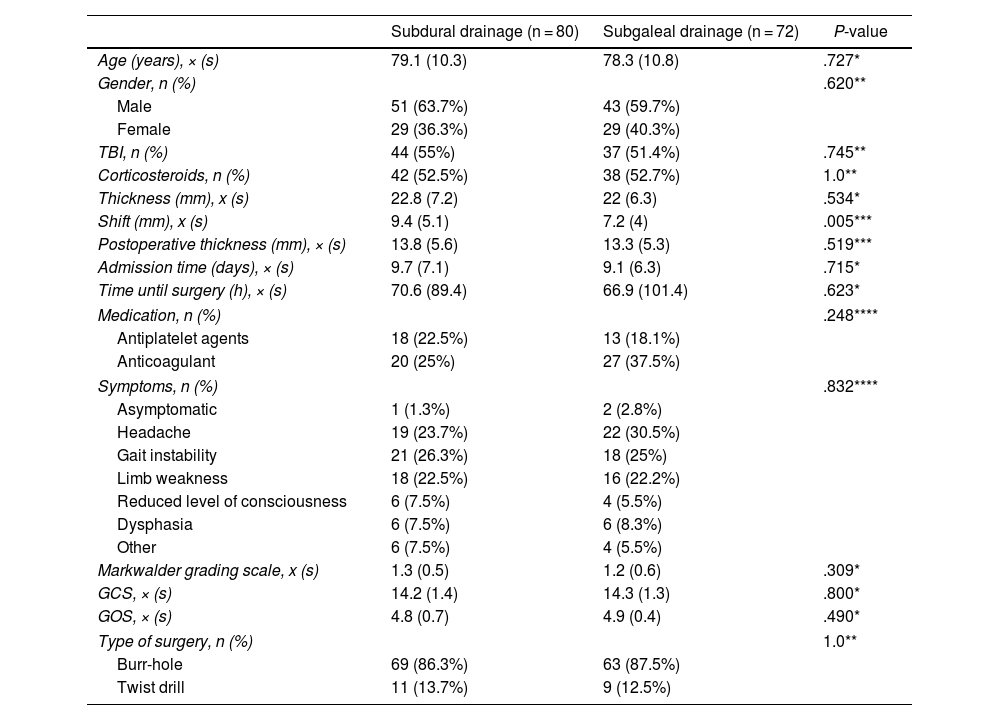Chronic subdural hematoma (CSDH) is one of the most common pathologies in our daily practice. The standard treatment is the evacuation making a burr-hole and placement of a subdural drainage, which has shown to decrease its recurrence. However, this procedure can entail risks such as parenchymal damage, infection, or the onset of seizures, prompting the consideration of subgaleal drainage as an alternative.
Our objective is to compare the use of subdural and subgaleal drainage in a cohort of patients undergoing intervention for CSDH, as well as to analyze the differences in complication rates and recurrence between the two groups.
MethodologyA retrospective analytical observational study was conducted, analyzing 152 patients diagnosed with CSDH who underwent intervention at our center from January 2020 to April 2022. Patients in whom drainage was not placed were excluded. In all patients, a burr-hole was performed and the type of drainage was chosen by the neurosurgeon.
ResultsOut of the 152 patients, subdural drainage was placed in 80 cases (52.63%), while subgaleal drainage was used in 72 cases (47.37%). There were no significant differences in the recurrence rate (30% in the subdural drainage group vs. 20.83% in the subgaleal drainage group; P = .134) or in the complication rate (7.5% in the subdural drainage group vs. 5.5% in the subgaleal drainage group; P = .749).
ConclusionsSubgaleal drainage shows similar clinical outcomes with a recurrence and complication rate comparable to subdural drainage, suggesting it as a safe and effective alternative to subdural drainage in the treatment of CSDH.
El hematoma subdural crónico (HSDc) es una de las patologías más comunes en nuestra práctica diaria. El tratamiento estándar es la evacuación mediante trépano y la colocación de drenaje subdural, el cual ha demostrado disminuir su recurrencia. Sin embargo, este procedimiento puede conllevar riesgos, como el daño al parénquima, la infección o la aparición de crisis comiciales, por lo que el drenaje subgaleal se plantea como una alternativa.
Nuestro objetivo es comparar el uso de drenaje subdural y subgaleal en una serie de pacientes con HSDc intervenidos, así como analizar las diferencias tanto en tasa de complicaciones como de recidiva entre ambos grupos.
MetodologíaSe realiza un estudio observacional analítico retrospectivo en el que se analizan 152 pacientes con diagnóstico de HSDc intervenidos en nuestro centro desde enero de 2020 hasta abril de 2022. Se excluyeron aquellos pacientes en los que no se colocó drenaje. En todos los pacientes se realizó un trépano y se colocó el tipo de drenaje a elección del neurocirujano.
ResultadosDe los 152 pacientes, en 80 se utilizó drenaje subdural (52,63%) y en 72 drenaje subgaleal (47,37%). No hubo diferencias significativas ni en la tasa de recidiva (30%) en el grupo de drenaje subdural vs 20,83%) en el grupo de drenaje subgaleal; P = ,134), ni en la de complicaciones (7,5% en el grupo de drenaje subdural vs 5,5% en el grupo de drenaje subgaleal; P = ,749).
ConclusionesEl drenaje subgaleal presenta los mismos resultados clínicos con un índice de recidivas y de complicaciones similar al drenaje subdural, por lo que se plantea como una opción segura y eficaz al drenaje subdural en el tratamiento del HSDc.
Article

If it is the first time you have accessed you can obtain your credentials by contacting Elsevier Spain in suscripciones@elsevier.com or by calling our Customer Service at902 88 87 40 if you are calling from Spain or at +34 932 418 800 (from 9 to 18h., GMT + 1) if you are calling outside of Spain.
If you already have your login data, please click here .
If you have forgotten your password you can you can recover it by clicking here and selecting the option ¿I have forgotten my password¿.










